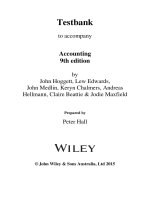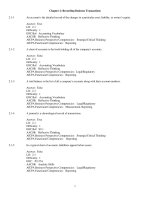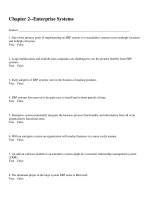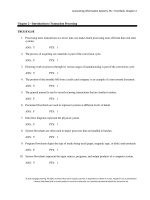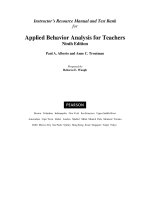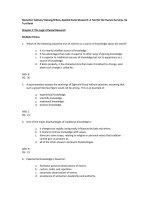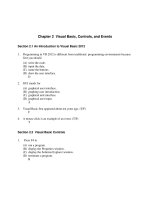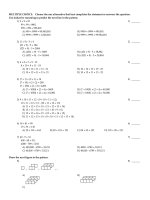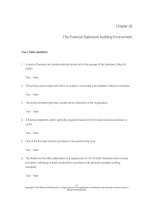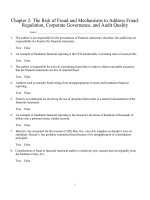Introductory statistics 9th edition weiss test bank
Bạn đang xem bản rút gọn của tài liệu. Xem và tải ngay bản đầy đủ của tài liệu tại đây (333.94 KB, 30 trang )
TABLE OF CONTENTS
INTRODUCTORY STATISTICS
CHAPTER 1 FORM A !
CHAPTER 1 FORM B!
CHAPTER 1 FORM C!
.......................................................................... !
..........................................................................
..........................................................................!
1
! !5
!9
CHAPTER 2 FORM A !
CHAPTER 2 FORM B!
CHAPTER 2 FORM C!
..........................................................................! !
..........................................................................! !
..........................................................................! !
13
21
30
CHAPTER 3 FORM A !
CHAPTER 3 FORM B!
CHAPTER 3 FORM C!
..........................................................................! !
..........................................................................! !
..........................................................................! !
40
45
49
CHAPTER 4 FORM A !
CHAPTER 4 FORM B!
CHAPTER 4 FORM C!
..........................................................................! !
..........................................................................! !
..........................................................................! !
54
61
68
CHAPTER 5 FORM A !
CHAPTER 5 FORM B!
CHAPTER 5 FORM C!
..........................................................................! !
..........................................................................! !
..........................................................................! !
76
80
84
CHAPTER 6 FORM A !
CHAPTER 6 FORM B!
CHAPTER 6 FORM C!
..........................................................................! !
..........................................................................! !
..........................................................................! !
104
109
115
CHAPTER 7 FORM A !
CHAPTER 7 FORM B!
CHAPTER 7 FORM C!
..........................................................................! !
..........................................................................! !
..........................................................................! !
135
139
143
CHAPTER 8 FORM A !
CHAPTER 8 FORM B!
CHAPTER 8 FORM C!
..........................................................................! !
..........................................................................! !
..........................................................................! !
147
150
153
CHAPTER 9 FORM A !
CHAPTER 9 FORM B!
CHAPTER 9 FORM C!
..........................................................................! !
..........................................................................! !
..........................................................................! !
156
164
172
CHAPTER 10 FORM A!
CHAPTER 10 FORM B!
CHAPTER 10 FORM C !
..........................................................................! !
..........................................................................! !
..........................................................................! !
199
206
214
CHAPTER 11 FORM A!
CHAPTER 11 FORM B!
CHAPTER 11 FORM C!
..........................................................................! !
..........................................................................! !
..........................................................................! !
240
243
247
CHAPTER 12 FORM A!
CHAPTER 12 FORM B!
CHAPTER 12 FORM C !
..........................................................................! !
..........................................................................! !
..........................................................................! !
251
255
259
CHAPTER 13 FORM A!
CHAPTER 13 FORM B!
CHAPTER 13 FORM C !
..........................................................................! !
..........................................................................! !
..........................................................................! !
264
272
280
CHAPTER 14 FORM A!
CHAPTER 14 FORM B!
CHAPTER 14 FORM C !
..........................................................................! !
..........................................................................! !
..........................................................................! !
288
293
299
CHAPTER 15 FORM A!
CHAPTER 15 FORM B!
CHAPTER 15 FORM C !
..........................................................................! !
..........................................................................! !
..........................................................................! !
305
313
320
CHAPTER 16 FORM A!
CHAPTER 16 FORM B!
CHAPTER 16 FORM C !
..........................................................................! !
..........................................................................! !
..........................................................................! !
348
354
360
ELEMENTARY STATISTICS
CHAPTER 1 FORM A !
CHAPTER 1 FORM B!
CHAPTER 1 FORM C!
..........................................................................
..........................................................................! !
..........................................................................! !
!!1
5
9
CHAPTER 2 FORM A !
CHAPTER 2 FORM B!
CHAPTER 2 FORM C!
..........................................................................! !
..........................................................................! !
..........................................................................! !
13
21
30
CHAPTER 3 FORM A !
CHAPTER 3 FORM B!
CHAPTER 3 FORM C!
..........................................................................! !
..........................................................................! !
..........................................................................! !
40
45
49
CHAPTER 4 FORM A !
CHAPTER 4 FORM B!
CHAPTER 4 FORM C!
..........................................................................! !
..........................................................................! !
..........................................................................! !
288
293
299
CHAPTER 5 FORM A !
CHAPTER 5 FORM B!
CHAPTER 5 FORM C!
..........................................................................! !
..........................................................................! !
..........................................................................! !
88
93
98
CHAPTER 6 FORM A !
CHAPTER 6 FORM B!
CHAPTER 6 FORM C!
..........................................................................! !
..........................................................................! !
..........................................................................! !
120
125
130
CHAPTER 7 FORM A !
CHAPTER 7 FORM B!
CHAPTER 7 FORM C!
..........................................................................! !
..........................................................................! !
..........................................................................! !
135
139
143
CHAPTER 8 FORM A !
CHAPTER 8 FORM B!
CHAPTER 8 FORM C!
..........................................................................! !
..........................................................................! !
..........................................................................! !
147
150
153
CHAPTER 9 FORM A !
CHAPTER 9 FORM B!
CHAPTER 9 FORM C!
..........................................................................! !
..........................................................................! !
..........................................................................! !
181
187
193
CHAPTER 10 FORM A!
CHAPTER 10 FORM B!
CHAPTER 10 FORM C !
..........................................................................! !
..........................................................................! !
..........................................................................! !
223
228
234
CHAPTER 11 FORM A!
CHAPTER 11 FORM B!
CHAPTER 11 FORM C!
..........................................................................! !
..........................................................................! !
..........................................................................! !
251
255
259
CHAPTER 12 FORM A!
CHAPTER 12 FORM B!
CHAPTER 12 FORM C !
..........................................................................! !
..........................................................................! !
..........................................................................! !
264
272
280
CHAPTER 13 FORM A!
CHAPTER 13 FORM B!
CHAPTER 13 FORM C !
..........................................................................! !
..........................................................................! !
..........................................................................! !
366
369
372
CHAPTER 14 FORM A!
CHAPTER 14 FORM B!
CHAPTER 14 FORM C !
..........................................................................! !
..........................................................................! !
..........................................................................! !
328
334
341
1
Introductory Statistics (IS) / Elementary Statistics (ES): Chapter 1 Form A Exam
Name _______________________________________________________________
SHORT ANSWER. Write the word or phrase that best completes each statement or answers the question.
Provide an appropriate response.
1) The table below shows the number of new AIDS cases in the U.S. in each
of the years 1989-1994.
Year
1989
1990
1991
1992
1993
1994
1)
New AIDS cases
33,643
41,761
43,771
45,961
103,463
61,301
Classify the study as either descriptive or inferential.
Answer the question.
2) A magazine publisher always mails out a questionnaire six months before
a subscription ends. This questionnaire asks its subscribers if they are
going to renew their subscriptions. On average, only 7% of the
subscribers respond to the questionnaire. Of the 7% who do respond, an
average of 47% say that they will renew their subscription. This 7% who
respond to the questionnaire are known as what?
2)
Identify the study as an observational study or a designed experiment.
3) An educational researcher used school records to determine that, in one
school district, 84% of children living in two-parent homes graduated
high school while 75% of children living in single-parent homes
graduated high school.
3)
Provide an appropriate response.
4) Why do statisticians sometimes use inferential statistics to draw
conclusions about a population? In what situations might a statistician
draw conclusions about a population using descriptive statistics only?
4)
Identify the study as an observational study or a designed experiment.
5) A clinic gives a drug to a group of ten patients and a placebo to another
group of ten patients to find out if the drug has an effect on the patients'
illness.
5)
List all possible samples from the specified population.
6) The six members of a board of directors are Sam (S), Laurie (L), Peggy (P),
Jorges (J), Max (M), and Claude (C). Consider these board members to be
a population of interest. List the 15 possible samples (without
replacement) of size four from this population of six board members.
6)
Copyright © 2012 Pearson Education, Inc. Publishing as Addison-Wesley.
2
Provide an appropriate response.
7) The finalists in an essay competition are Lisa (L), Melina (M), Ben (B),
Danny (D), Eric (E), and Joan (J). Consider these finalists to be a
population of interest. The possible samples (without replacement) of size
three that can be obtained from this population of six finalists are as
follows.
7)
L,M,B L,M,D L,M,E L,M,J L,B,D L,B,E
L,B,J L,D,E L,D,J L,E,J M,B,D M,B,E
M,B,J M,D,E M,D,J M,E,J B,D,E B,D,J
If a simple random sampling method is used to obtain a sample of three
of the finalists, what are the chances of selecting Ben, Danny, and Joan?
Use the random number table in Appendix A to obtain the required list of random numbers.
8) A company employs 5382 people and wishes to interview a random
sample of 14 of them with regard to the company's health insurance
policy. Construct a list of 14 random numbers between 1 and 5382 that
can be used in obtaining the required simple random sample. Use the
random number table and use as your starting point the digits 0691 in
row 3, columns 30-33.
8)
Provide an appropriate response.
9) A political researcher wishes to gauge political sentiment regarding a
proposed tax cut. He obtains a list of 1000 email addresses from an
internet provider, uses a random number table to select a random sample
of 100 of these addresses, emails the people in the sample and requests
that they respond to his questions by email. Do you think that the group
of people who respond is likely to be representative of all registered
voters? Explain your answer.
9)
10) True or false? In simple random sampling, each possible sample is
equally likely to be the one obtained.
10)
11) From a group of 496 students, every 49th student starting with the 3rd
student is selected. Identify the type of sampling used in this example.
11)
12) Describe the steps involved when using stratified random sampling with
proportional allocation. What are the advantages of this sampling
method?
12)
Copyright © 2012 Pearson Education, Inc. Publishing as Addison-Wesley.
3
A designed experiment is described. Identify the specified element of the experiment.
13) In a clinical trial, 780 participants suffering from high blood pressure
were randomly assigned to one of three groups. Over a one-month
period, the first group received a low dosage of an experimental drug, the
second group received a high dosage of the drug, and the third group
received a placebo. The diastolic blood pressure of each participant was
measured at the beginning and at the end of the period and the change in
blood pressure was recorded. Identify the response variable.
13)
14) An education researcher was interested in examining the effect of the
teaching method and the effect of the particular teacher on students'
scores on a reading test. In a study, there are four different teachers
(Juliana, Felix, Sonia, and Helen) and three different teaching methods
(method A, method B, and method C). The number of students
participating in the study is 258. Students are randomly assigned to a
teaching method and teacher. Identify the experimental units (subjects).
14)
Provide an appropriate response.
15) In a designed experiment, explain the difference between the treatments
and the factors.
15)
Copyright © 2012 Pearson Education, Inc. Publishing as Addison-Wesley.
4
Answer Key
Testname: ISES CHAPTER 1 FORM A
1)
2)
3)
4)
Descriptive
The sample
Observational study
If a population is large, it may be too expensive and time-consuming to interview every member of
the population. In such cases, a sample is drawn from the population, and based on the information
in the sample, conclusions are drawn about the population; in other words, inferential statistics are
used. If the population is relatively small, it may be realistic to interview every member of the
population, in which case only descriptive statistics are needed.
5) Designed experiment
6) S,L,P,J S,L,P,M S,L,P,C S,L,J,M S,L,J,C S,L,M,C S,P,J,M S,P,J,C
S,P,M,C S,J,M,C L,P,J,M L,P,J,C L,P,M,C L,J,M,C P,J,M,C
1
7)
20
8) 691, 3863, 3034, 978, 4584, 99, 362, 245, 1788, 4947, 471, 1562, 684, 2598
9) No; explanations will vary. Possible answer: the sample was obtained from among people who own a
computer. That group is likely to include relatively wealthy people who are more likely to favor a tax
cut. Furthermore, the group includes those who chose voluntarily to respond. People who respond
voluntarily are likely to have stronger opinions than the average voter.
10) True
11) Systematic random sampling
12) Answers will vary. Possible answer: The population is first divided into subpopulations (strata).
From each stratum, a simple random sample is obtained whose size is proportional to the size of the
stratum. The advantage of this method is that it ensures that no stratum is missed.
13) Change in diastolic blood pressure
14) The 258 students participating in the study
15) Answers will vary. Possible answer: the factors are the variables whose effect on the response
variable is of interest. The treatments are the various experimental conditions. In a single-factor
experiment, the treatments are the levels of the factor. In a multi-factor experiment, each treatment is
a combination of levels of the factors.
Copyright © 2012 Pearson Education, Inc. Publishing as Addison-Wesley.
5
Introductory Statistics (IS) / Elementary Statistics (ES): Chapter 1 Form B Exam
Name _______________________________________________________________
SHORT ANSWER. Write the word or phrase that best completes each statement or answers the question.
Provide an appropriate response.
1) The table below shows the average income by age group for the residents
of one town in the year 1998. The average incomes for each age group are
estimates based on a sample of size 100 from each group.
Age group
18-24
25-39
40-54
55-70
Over 70
1)
Average income
$17,180
$26,661
$32,471
$25,960
$18,241
Classify the study as either descriptive or inferential.
Answer the question.
2) The spell-checker in a desktop publishing application may not catch all
misspellings (e.g. their, there) or correctly interpret the spellings of proper
names. Jackie is an expert editor and can proofread extremely quickly.
Jackie is hired by a book publisher to check the spelling of every word in
the latest proof of a history book. With regard to Jackie's assignment,
what is the population?
2)
Identify the study as an observational study or a designed experiment.
3) At one hospital in 1992, 674 women were diagnosed with breast cancer.
Five years later, 88% of the Caucasian women and 83% of the African
American women were still alive.
3)
Provide an appropriate response.
4) Fill in the following blanks: The two major types of statistics are
______________ statistics and ___________ statistics.
4)
List all possible samples from the specified population.
5) Given a group of students: Allen (A), Brenda (B), Chad (C), Dorothy (D),
and Eric (E), list all of the possible samples (without replacement) of size
four that can be obtained from the group.
5)
Copyright © 2012 Pearson Education, Inc. Publishing as Addison-Wesley.
6
Provide an appropriate response.
6) The finalists in an essay competition are Lisa (L), Melina (M), Ben (B),
Danny (D), Eric (E), and Joan (J). Consider these finalists to be a
population of interest. The possible samples (without replacement) of
size two that can be obtained from this population of six finalists are as
follows.
6)
L,M L,B L,D L,E L,J M,B M,D
M,E M,J B,D B,E B,J D,E D,J E,J
If a simple random sampling method is used to obtain a sample of two of
the finalists, what are the chances of selecting Lisa and Danny?
Use the random number table in Appendix A to obtain the required list of random numbers.
7) A market researcher is conducting a telephone poll. She has a list of 581
registered voters and wishes to interview a random sample of 12 of them.
Construct a list of 12 random numbers between 1 and 581 that can be
used in obtaining the required simple random sample. Use the random
number table and use as your starting point the digits 432 in row 13,
columns 10-12.
7)
Provide an appropriate response.
8) A political researcher wishes to gauge political sentiment regarding a
proposed tax cut. He obtains a list of 1000 email addresses from an
internet provider, uses a random number table to select a random sample
of 100 of these addresses, emails the people in the sample and requests
that they respond to his questions by email. Do you think that the group
of people who respond is likely to be representative of all registered
voters? Explain your answer.
8)
9) A mega-discount chain store just opened a new clothing store in town
emphasizing mainly women's clothing. Before opening, management
had to decide whether to only carry either men's, women's, boys', girls',
or infants' clothing. After performing representative sampling of
potential customers from each of these groups, it was decided to carry
only women's clothing. Identify the type of sampling used in this
example.
9)
10) The residents of one town are classified by a social scientist as follows.
10)
Lower income: 1274
Middle income: 6279
Upper income: 1547
The scientist wishes to pick a sample of 200 of the residents for a study.
Describe a method for selecting the sample which involves stratified
sampling with proportional allocation.
Copyright © 2012 Pearson Education, Inc. Publishing as Addison-Wesley.
7
A designed experiment is described. Identify the specified element of the experiment.
11) In a clinical trial, 780 participants suffering from high blood pressure
were randomly assigned to one of three groups. Over a one-month
period, the first group received a low dosage of an experimental drug, the
second group received a high dosage of the drug, and the third group
received a placebo. The diastolic blood pressure of each participant was
measured at the beginning and at the end of the period and the change in
blood pressure was recorded. Identify the experimental units (subjects).
11)
12) In a clinical trial, 780 participants suffering from high blood pressure
were randomly assigned to one of three groups. Over a one-month
period, the first group received a low dosage of an experimental drug, the
second group received a high dosage of the drug, and the third group
received a placebo. The diastolic blood pressure of each participant was
measured at the beginning and at the end of the period and the change in
blood pressure was recorded. Identify the factor.
12)
13) A herpetologist performed a study on the effects of the body type and
mating call of the male bullfrog as signals of quality to mates. Four
life-sized dummies of male bullfrogs and two sound recordings provided
a tool for testing female response to the unfamiliar frogs whose bodies
varied by size (large or small) and color (dark or light) and whose mating
calls varied by pitch (high, normal, or low). The female bullfrogs were
observed to see whether they approached each of the four life-sized
dummies. Identify the experimental units.
13)
14) An education researcher was interested in examining the effect of the
teaching method and the effect of the particular teacher on students'
scores on a reading test. In a study, there are four different teachers
(Juliana, Felix, Sonia, and Helen) and three different teaching methods
(method A, method B, and method C). The number of students
participating in the study is 258. Students are randomly assigned to a
teaching method and teacher. Identify the experimental units (subjects).
14)
Provide an appropriate response.
15) Describe a double-blind experiment and explain why blinding is used.
Define the term "placebo effect" as part of the answer.
15)
Copyright © 2012 Pearson Education, Inc. Publishing as Addison-Wesley.
8
Answer Key
Testname: ISES CHAPTER 1 FORM B
1)
2)
3)
4)
5)
Inferential
Every word in the latest proof of the history book
Observational study
descriptive and inferential
A,B,C,D A,B,C,E A,C,D,E A,D,E,B B,C,D,E
1
6)
15
7) 432, 452, 534, 16, 343, 242, 428, 378, 163, 182, 293, 422
8) No; explanations will vary. Possible answer: the sample was obtained from among people who own a
computer. That group is likely to include relatively wealthy people who are more likely to favor a tax
cut. Furthermore, the group includes those who chose voluntarily to respond. People who respond
voluntarily are likely to have stronger opinions than the average voter.
9) Stratified sampling
10) Answers will vary. Possible answer: Proportional allocation dictates that the number of lower income,
middle income, and upper income residents selected by the scientist be 28, 138, and 34, respectively.
Thus the scientist can obtain a stratified sample of 200 residents as follows: Number the lower income
residents from 1 through 1274 and use table of random numbers to randomly select 28 of the 1274
lower income residents; number the middle income residents from 1 to 6279 and use a table of
random numbers to randomly select 138 of the 6279 middle income residents; number the upper
income residents from 1 to 1547 and use a table of random numbers to randomly select 34 of the 1547
upper income residents.
11) The participants in the experiment
12) The experimental drug
13) The female bullfrogs
14) The 258 students participating in the study
15) A double-blind experiment is one in which neither the subjects nor the researchers know who is
getting the treatment. Blinding is when the subject does not know whether he or she is receiving a
treatment or a placebo. Blinding is used to counteract the placebo effect in which an untreated subject
believes he or she is receiving a treatment and reports an improvement in symptoms due to this
belief.
Copyright © 2012 Pearson Education, Inc. Publishing as Addison-Wesley.
9
Introductory Statistics (IS) / Elementary Statistics (ES): Chapter 1 Form C Exam
Name _______________________________________________________________
SHORT ANSWER. Write the word or phrase that best completes each statement or answers the question.
Provide an appropriate response.
1) A researcher randomly selects a sample of 100 students from the students
enrolled at a particular college. She asks each student his age and
calculates the mean age of the 100 students. It is 21.3 years. Based on this
sample, she then estimates the mean age of all students enrolled at the
college to be 21.3 years. In what way are descriptive statistics involved in
this example? In what way are inferential statistics involved?
1)
Answer the question.
2) A computer network manager wants to test the reliability of some new
and expensive fiber-optic Ethernet cables that computer department just
received. The computer department received 7 boxes containing 50 cables
each. The manager does not have the time to test every cable in each box.
The manager will choose one box at random and test 10 cables chosen
randomly within that box. What is the sample?
2)
Identify the study as an observational study or a designed experiment.
3) In a group of 500 men and women, those who smoked did worse on tests
of reaction time than those who did not smoke.
3)
Provide an appropriate response.
4) Define the terms population and sample.
4)
List all possible samples from the specified population.
5) The members of a board of directors have the following roles:
president (P), vice president (V), secretary (S), treasury (T), and
fundraiser (F). Consider these board members to be a population of
interest. List the 10 possible samples (without replacement) of size two
from this population of five board members.
5)
Provide an appropriate response.
6) The finalists in an essay competition are Lisa (L), Melina (M), Ben (B),
Danny (D), Eric (E), and Joan (J). Consider these finalists to be a
population of interest. The possible samples (without replacement) of
size two that can be obtained from this population of six finalists are as
follows.
6)
L,M L,B L,D L,E L,J M,B M,D
M,E M,J B,D B,E B,J D,E D,J E,J
If a simple random sampling method is used to obtain a sample of two of
the finalists, what are the chances of selecting Lisa and Danny?
Copyright © 2012 Pearson Education, Inc. Publishing as Addison-Wesley.
10
Use the random number table in Appendix A to obtain the required list of random numbers.
7) A medical researcher is conducting clinical trials. Of the 60 people
participating in the trial, 20 will receive a placebo, 20 will receive the
experimental drug, and 20 will constitute the control group. The 20
people who will receive the drug will be selected at random. Construct a
list of 20 random numbers between 1 and 60 which can be used in
obtaining the required simple random sample. Use the random number
table and use as your starting point the digits 54 in row 15, columns
20-21.
7)
Provide an appropriate response.
8) Define probability sampling. Identify some advantages of probability
sampling.
8)
9) At a college there are 120 freshmen, 90 sophomores, 110 juniors, and 80
seniors. A school administrator selects a simple random sample of 12 of
the freshmen, a simple random sample of 9 of the sophomores, a simple
random sample of 11 of the juniors, and a simple random sample of 8 of
the seniors. She then interviews all the students selected. Identify the type
of sampling used in this example.
9)
10) Geologists have an interest in the structure and the history of the earth.
A geologist can go back in time by drilling deep into the ground,
retrieving a core sample, estimating the ages of the various layers, and
examining the composition. A timeline can be built of the entire area
from where the core sample was drilled. A geologist may retrieve several
core samples to confirm the history of the earth's structure in that
sampled area. Mountains, lakes, and unstable ground can easily impede
a simple random sampling of a desired geographical area, therefore what
is the most realistic sampling method that represents the actual drillings,
comparisons, and scientific examinations of several core samples within
the same geographical area?
10)
11) Describe the advantages and disadvantages of cluster sampling as
compared with simple random sampling.
11)
Copyright © 2012 Pearson Education, Inc. Publishing as Addison-Wesley.
11
MULTIPLE CHOICE. Choose the one alternative that best completes the statement or answers the
question.
A designed experiment is described. Identify the specified element of the experiment.
12) In a clinical trial, 780 participants suffering from high blood pressure were
randomly assigned to one of three groups. Over a one -month period, the first
group received a low dosage of an experimental drug, the second group received
a high dosage of the drug, and the third group received a placebo. The diastolic
blood pressure of each participant was measured at the beginning and at the end
of the period and the change in blood pressure was recorded. Identify the
response variable.
12)
A) The participants in the experiment
B) Change in diastolic blood pressure
C) The dosage of the drug
D) The treatment received (placebo, low dosage, high dosage)
SHORT ANSWER. Write the word or phrase that best completes each statement or answers the question.
13) A herpetologist performed a study on the effects of the body type and
mating call of the male bullfrog as signals of quality to mates. Four
life-sized dummies of male bullfrogs and two sound recordings provided
a tool for testing female response to the unfamiliar frogs whose bodies
varied by size (large or small) and color (dark or light) and whose mating
calls varied by pitch (high, normal, or low). The female bullfrogs were
observed to see whether they approached each of the four life-sized
dummies. Identify the response variable.
13)
Provide an appropriate response.
14) In a designed experiment, explain the difference between the treatments
and the factors.
14)
15) A study was conducted to evaluate the effectiveness of a new diet pill for
men. A group of 3000 men were involved in the study. Of these 3000 men,
2311 took the diet pill and 889 were given a placebo. Identify the
treatments, the treatment group, and the control group.
15)
Copyright © 2012 Pearson Education, Inc. Publishing as Addison-Wesley.
12
Answer Key
Testname: ISES CHAPTER 1 FORM C
1) When calculating the mean age of the students in the sample, the researcher is using descriptive
statistics. When estimating the mean age of all students at the college, the researcher is using
inferential statistics.
2) The 10 cables chosen for testing
3) Observational study
4) A population is the complete collection of all individuals or items under consideration in a statistical
study. A sample is that part of the population from which information is obtained.
5) P,V P,S P,T P,F V,S V,T V,F S,T S,F T,F
1
6)
15
7) 54, 2, 3, 41, 24, 19, 8, 30, 4, 6, 36, 15, 14, 40, 1, 5, 39, 42, 58, 10
8) Probability sampling consists of using a randomizing device such as tossing a coin or consulting a
random number table to decide which members of the population will constitute the sample.
Probability sampling eliminates unintentional selection bias, permits the researcher to control the
chance of obtaining a non-representative sample, and guarantees that the techniques of inferential
statistics can be applied.
9) Stratified sampling
10) Cluster sampling
11) Answers will vary. Possible answer: Cluster sampling can save time when members of the
population are widely scattered geographically. The disadvantage is that members of a cluster may
be more homogeneous than the members of the population as a whole and may not mirror the entire
population.
12) B
13) Whether or not (yes or no) the female frogs approached a male dummy
14) Answers will vary. Possible answer: the factors are the variables whose effect on the response
variable is of interest. The treatments are the various experimental conditions. In a single-factor
experiment, the treatments are the levels of the factor. In a multi-factor experiment, each treatment is
a combination of levels of the factors.
15) Treatments: diet pill and placebo
Treatment group: the 2311 men who took the diet pill
Control group: the 889 men who took the placebo
Copyright © 2012 Pearson Education, Inc. Publishing as Addison-Wesley.
13
Introductory Statistics (IS) / Elementary Statistics (ES): Chapter 2 Form A Exam
Name _______________________________________________________________
SHORT ANSWER. Write the word or phrase that best completes each statement or answers the question.
Classify the data as either qualitative or quantitative.
1) The following table gives the top five movies at the box office this week.
Rank
1
2
3
4
5
Last week
N/A
2
1
5
4
Movie title
Pirate Adventure
Secret Agent Files
Epic Super Hero Team
Reptile Ride
Must Love Cats
Studio
Movie Giant
G.M.G.
21st Century
Movie Giant
Dreamboat
1)
Box office sales ($ mi
35.2
19.5
14.3
10.1
9.9
What kind of data is provided by the information in the first column?
Classify the data as either discrete or continuous.
2) What type of data is provided by the statement "Helen finished in 8th
place in the ice dancing competition"?
2)
Identify the variable.
3) A large record company reported the following sales figures for various
music media last year.
Media
CD
CD single
MP3
Vinyl
Music video
Mini Disc
DVD
Cassette
3)
Sales ($ millions)
1477.3
1.8
65.9
2.6
531.4
0.3
108.2
3.4
Identify the variable under consideration in the second column?
Tell whether the statement is true or false.
4) A variable whose possible values are 1.15, 1.20, 1.25, 1.30, 1.35, 1.40, 1.45,
1.50, 1.55, 1.60, is a continuous variable.
4)
Copyright © 2012 Pearson Education, Inc. Publishing as Addison-Wesley.
14
Construct a frequency distribution for the given qualitative data.
5) The blood types for 40 people who agreed to participate in a medical
study were as follows.
O
A
A
O
A
O
B
A
A
A
O
O
O
B
A
O
O
O
A
A
AB
O
O
B
O
O
O
O
B
AB
B
O
A
A
O
A
5)
O
A
O
AB
Construct a frequency distribution for the data.
Provide an appropriate response.
6) The preschool children at Elmwood Elementary School were asked to
name their favorite color. The results are listed below. Construct a
frequency distribution and a relative frequency distribution.
blue
purple
purple
red
blue
purple
red
purple
red
blue
green
green
green
purple
green
purple
6)
purple
red
green
yellow
Construct a pie chart representing the given data set.
7) The data below represent the results of a poll in which the the following
question was asked: "To what degree are you satisfied with the outcome
of the 2006 mayoral election?"
Very
Somewhat
Not at All
No opinion
7)
17%
22%
39%
22%
Construct the requested graph.
8) Construct a bar graph for the relative frequencies given.
Blood
type
O
A
B
AB
Frequency
Relative
frequency
22
19
6
3
0.44
0.38
0.12
0.06
8)
Copyright © 2012 Pearson Education, Inc. Publishing as Addison-Wesley.
15
Provide an appropriate response.
9) Suppose you are comparing frequency data for two different groups, 25
managers and 150 blue collar workers. Why would a relative frequency
distribution be better than a frequency distribution?
9)
Use single-value grouping to organize these data into a frequency distribution.
10) The following data represent the total number of years of formal
education for 40 employees of a bank.
13
16
14
12
17
18
15
17
13
13
13
17
14
11
15
16
12
19
17
16
17
19
18
17
19
12
17
15
13
14
14
13
15
13
13
13
10)
13
13
17
14
Construct a frequency distribution for the number of years of education.
Provide the requested table entry.
11) The data in the following table represent heights of students at a
highschool. Find the value of the missing entry.
11)
Height
Relative
(centimeters) frequency
142-under 152
0.03
152-under 162
0.21
162-under 172
0.27
172-under 182
0.28
182-under 192
192-under 202
0.02
Construct a dotplot for the given data.
12) Attendance records at a school show the number of days each student
was absent during the year. The days absent for each student were as
follows.
934286340673422
12)
Copyright © 2012 Pearson Education, Inc. Publishing as Addison-Wesley.
16
A nurse measured the blood pressure of each person who visited her clinic. Following is a
relative-frequency histogram for the systolic blood pressure readings for those people aged between 25
and 40. Use the histogram to answer the question. The blood pressure readings were given to the nearest
whole number.
13) Approximately what percentage of the people aged 25-40 had a systolic
blood pressure reading greater than or equal to 130?
13)
Complete the contingency table and use it to solve the problem.
14) The partially filled contingency table gives the relative frequencies of the
data on age (in years) and sex from the residents of a retirement home.
Age (yrs)
60-69
70-79
Over 79
Total
Male
0.17
0.1
0.13
Female
0.2
0.2
0.2
Total
1
14)
What percentage of residents are females in the age group 70-79?
Copyright © 2012 Pearson Education, Inc. Publishing as Addison-Wesley.
17
Provide the requested response.
15) The table contains data from a study of daily study time for 40 students
from Statistics 101. Construct an ogive from the data.
15)
Minutes on
Number of Relative
Cumulative
homework
students
frequency relative frequency
0-under 15
2
0.05
0.05
15-under 30
4
0.10
0.15
30-under 45
8
0.20
0.35
45-under 60
18
0.45
0.80
60-under 75
4
0.10
0.90
75-under 90
4
0.10
1.00
Provide an appropriate response.
16) When organizing data into tables, what is the disadvantage of having too
many classes? What is the disadvantage of having too few classes?
16)
A graphical display of a data set is given. Identify the overall shape of the distribution as (roughly)
bell-shaped, triangular, uniform, reverse J-shaped, J-shaped, right skewed, left skewed, bimodal, or
multimodal.
17) A frequency histogram is given below for the weights of a sample of
college students.
17)
Copyright © 2012 Pearson Education, Inc. Publishing as Addison-Wesley.
18
A graphical display of a data set is given. State whether the distribution is (roughly) symmetric, right
skewed, or left skewed.
18) A stem-and-leaf diagram is given below for the number of vacation days
taken in 2006 by the employees of an electronics company.
0
1
2
3
4
18)
401363584368002
14251403010
02034
01
3
Provide an appropriate response.
19) The bar graph below shows the number of car accidents occurring in one
city in each of the years 2001 through 2006. The number of accidents
dropped in 2003 after a new speed limit was imposed. Why is the graph
misleading? How would you redesign the graph to be less misleading?
19)
Copyright © 2012 Pearson Education, Inc. Publishing as Addison-Wesley.
19
Answer Key
Testname: ISES CHAPTER 2 FORM A
1)
2)
3)
4)
5)
Quantitative
Discrete
sales
False
Blood type
O
A
B
AB
Frequency
19
13
5
3
6)
Color Frequency Relative Frequency
blue
3
0.15
red
4
0.20
green
5
0.25
purple
7
0.35
yellow
1
0.05
7)
8)
9) Answers will vary. Possible answer: Since the two groups are of different sizes, comparing the
number (frequency) of managers falling into a given class with the number of employees falling in
the same class would not be very meaningful. It would be more useful to compare the proportion
(relative frequency) of managers falling into a given class with the proportion of employees falling in
the same class.
Copyright © 2012 Pearson Education, Inc. Publishing as Addison-Wesley.
20
Answer Key
Testname: ISES CHAPTER 2 FORM A
10)
Number of
years of
education Frequency
11
1
12
3
13
11
14
5
15
4
16
3
17
8
18
2
19
3
11) 0.19
12)
13) 26%
14) 20%
15)
16) Answers will vary. Possible answer: With too many classes it may be difficult to get a clear picture of
the data and to see trends in the data - the amount of information may be overwhelming. With too
few classes, it may also be difficult to see important characteristics in the data as the data may have
been over-summarized and too much information may have been lost.
17) Bimodal
18) Right skewed
19) Answers will vary. Possible answer: The graph is misleading because it is truncated. The scale on the
vertical axis should start at zero so that the bars will be in the correct proportions. A part of the
vertical axis could be omitted but the symbol // should then be used to warn the reader of the
modified axis.
Copyright © 2012 Pearson Education, Inc. Publishing as Addison-Wesley.
21
Introductory Statistics (IS) / Elementary Statistics (ES): Chapter 2 Form B Exam
Name _______________________________________________________________
SHORT ANSWER. Write the word or phrase that best completes each statement or answers the question.
Classify the data as either qualitative or quantitative.
1) The following table gives the top five movies at the box office this week.
Rank
1
2
3
4
5
Last week
N/A
2
1
5
4
Movie title
Pirate Adventure
Secret Agent Files
Epic Super Hero Team
Reptile Ride
Must Love Cats
Studio
Movie Giant
G.M.G.
21st Century
Movie Giant
Dreamboat
1)
Box office sales ($ mi
35.2
19.5
14.3
10.1
9.9
What kind of data is provided by the information in the second column?
Classify the data as either discrete or continuous.
2) The average height of all freshmen entering college in a certain year is
68.4 inches.
2)
Identify the variable.
3) The following table gives the top five movies at the box office this week.
Rank
1
2
3
4
5
Last week
N/A
2
1
5
4
Movie title
Pirate Adventure
Secret Agent Files
Epic Super Hero Team
Reptile Ride
Must Love Cats
Studio
Movie Giant
G.M.G.
21st Century
Movie Giant
Dreamboat
3)
Box office sales ($ mi
35.2
19.5
14.3
10.1
9.9
Identify the variable under consideration in the fourth column?
Tell whether the statement is true or false.
4) Arranging the age of students in a class in from youngest to oldest yields
ordinal data.
4)
Copyright © 2012 Pearson Education, Inc. Publishing as Addison-Wesley.
